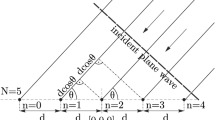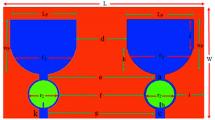Abstract
In this paper, we propose a general target model for multiple-input multiple-output (MIMO) radar. Two types of targets are presented. For each type of target, we develop a corresponding optimum waveform designing method to optimize detection performance. Based on Chernoff-Stein lemma, we use relative entropy as the performance measure. We show that the optimum waveform designing method can obtain better detection performance than traditional orthogonal waveform designing method.
Similar content being viewed by others
References
Li J, Stoica P. MIMO Radar Signal Processing. Hoboken: John Wiley & Sons, Inc., 2008
Fishler E, Haimovich A, Blum R, et al. MIMO radar: An idea whose time has come. In: Proceedings of the IEEE Radar Conference, Philadelphia, 2004. 71–78
San Antonio G, Fuhrmann D R, Robey F C. MIMO radar ambiguity functions. IEEE J Sel Top Signal Process, 2007, 1: 167–177
Lehmann N, Fishler E, Haimovich A, et al. Evaluation of transmit diversity in MIMO radar direction finding. IEEE Trans Signal Process, 2007, 55: 2215–2225
Chen C, Vaidyanathan P. A subspace method for MIMO radar space-time adaptive processing. In: Proceedings of the IEEE International Conference on Acoustics, Speech, and Signal Processing, Hawaii, 2007. 2: 925–928
Bekkerman I, Tabrikian J. Target detection and localization using MIMO radars and sonars. IEEE Trans Signal Process, 2006, 54: 3873–3883
Fishler E. Spatial diversity in radars-models and detection performance. IEEE Trans Signal Process, 2006, 54: 823–838
Tang J, Li N, Wu Y, et al. On detection performance of MIMO radar: A relative entropy-based study. IEEE Signal Process Lett, 2009, 16: 184–187
Bliss D, Forsythe K. Multiple-input multiple-output (MIMO) radar and imaging: Degrees of freedom and resolution. In: Proceedings of the 37th Asilomar Conference on Signals, Systems and Computers, Pacific Grove, 2003. 1: 54–59
Li J, Stoica P, Xu L, et al. On parameter identifiability of MIMO radar. IEEE Signal Process Lett, 2007, 14: 968–971
Li J, Stoica P. MIMO radar with colocated antennas: Review of some recent work. IEEE Signal Process Mag, 2007, 24: 106–114
Sammartino P, Baker C, Griffiths H. A comparison of algorithms for MIMO and netted radar systems. In: Proceedings of the 2nd International Waveform Diversity & Design Conference, Orlando, 2006. 22–27
Maio A, Lops M. Design principles of MIMO radar detectors. IEEE Trans Aerosp Electron Syst, 2007, 43: 886–897
Wu Y, Tang J, Peng Y. Models and performance evaluation for multiple-input multiple-output space-time adaptive processing radar. IET Radar Sonar Navig, 2009, 3: 569–582
Deng H. Polyphase code design for orthogonal netted radar systems. IEEE Trans Signal Process, 2004, 52: 3126–3135
Kay S. Waveform design for multistatic radar detection. IEEE Trans Aerosp Electron Syst, 2009, 45: 1153–1166
Li J, Xu L, Stoica P, et al. Range compression and waveform optimization for MIMO radar: A Cramer-Rao bound based study. IEEE Trans Signal Process, 2008, 56: 218–232
He H, Stoica P, Li J. Designing unimodular sequence sets with good correlationsIncluding an application to MIMO radar. IEEE Trans Signal Process, 2009, 57: 4391–4405
Yang Y, Blum R. Minimax robust MIMO radar waveform design. IEEE J Sel Top Signal Process, 2007, 1: 147–155
Tse D, Viswanath P. Fundamentals of Wireless Communication. Cambridge: Cambridge University Press, 2005. 35
Cover T M, Thomas J A. Elements of Information Theory. 2nd ed. Hoboken: John Wiley & Sons, Inc., 2006. 383
Seber G. A Matrix Handbook for Statisticans. Hoboken: John Wiley & Sons, Inc., 2007. 56
Author information
Authors and Affiliations
Corresponding author
Rights and permissions
About this article
Cite this article
Tang, J., Luo, J., Tang, B. et al. Target models and waveform design for detection in MIMO radar. Sci. China Inf. Sci. 57, 1–12 (2014). https://doi.org/10.1007/s11432-012-4719-z
Received:
Accepted:
Published:
Issue Date:
DOI: https://doi.org/10.1007/s11432-012-4719-z




